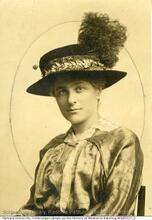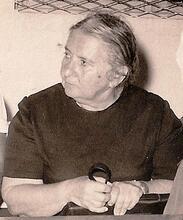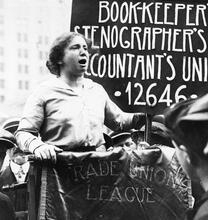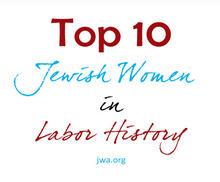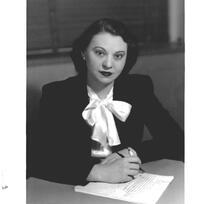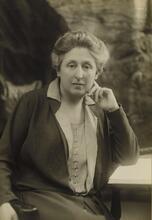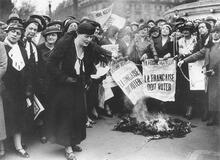Anna Rosenberg
In 1944, Anna Rosenberg served as President Franklin Roosevelt's personal representative in Europe and in 1945 President Harry Truman sent her to the European theater to study military personnel problems. This 1951 photograph with General George C. Marshall and Lyndon Johnson was taken in Washington, D.C.
Courtesy of Thomas Rosenberg
Anna Lederer Rosenberg was an administrator, diplomat, and public relations and manpower expert who advised multiple presidents. During the New Deal, she moved from campaign management into government administration, becoming an adviser to Franklin Roosevelt and Harry Truman. In 1944 she served as President Roosevelt’s personal representative in Europe, and the following year President Truman sent her to the European theater to study military manpower problems. Between 1934 and 1945 she held numerous leadership positions in government, including regional director of the National Recovery Administration. In 1950 she became the first female Assistant Secretary of Defense, through which she was responsible for military manpower requirements. Deeply admired by military and government leaders, Rosenberg’s success demonstrates how deftly she maneuvered within these male-dominated arenas.
Early Life & Campaign Management Career
The first woman to serve as assistant secretary of defense, Anna Lederer Rosenberg achieved distinction in government and business. She was born on July 19, 1901, to Albert and Charlotte (Bacskai) Lederer in Budapest, Hungary. Rosenberg immigrated to the United States with her family in 1912, after her father’s business failed, and was naturalized in 1919. She attended Wadleigh High School in Manhattan. As an adolescent during World War I, Lederer sold Liberty Bonds and was a volunteer nurse in an embarkation hospital. Later, she held some of the highest government posts ever occupied by a woman and received recognition for her efficiency, intelligence, energy, and for a certain brashness. She married Julius Rosenberg, a rug merchant, at age twenty and had a son, Thomas, at age twenty-one.
During the 1920s Rosenberg gained experience in politics and philanthropy. A speech she made advocating woman suffrage brought her to the attention of Jim Hagan, a Tammany district leader. Rosenberg became active in Manhattan’s seventh Assembly District Democratic Party Organization. She got her start managing campaigns for Walter Hagan (for alderman) and John Buckley (for assemblyman) in 1922. She also managed James J. Hagan’s campaign to retain leadership of the seventh Assembly District and Saul Streit’s run for the Assembly. In 1924 she opened a public relations office with a specialty in personnel and labor issues. By the early 1930s she had established a reputation in New York as an expert in public relations and manpower.
Government Administration & Private Consulting
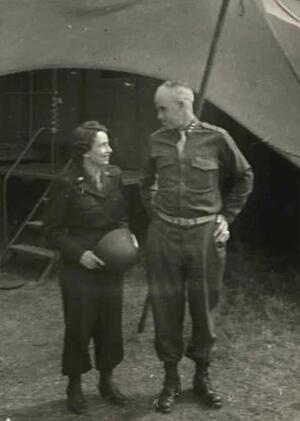
The first woman to serve as United States assistant secretary of defense and the first woman to receive that nation's Medal for Merit, Anna Lederer Rosenberg succeeded in two male-dominated worlds, government and business. She is shown here with General Omar Bradley in France in 1944.
Courtesy of Thomas Rosenberg
During the New Deal, Rosenberg moved into government administration, holding increasingly important roles. A committed Democrat, she became a trusted adviser to Franklin Roosevelt, Harry Truman, New York Mayor Fiorello LaGuardia, and New York Governor Herbert Lehman. She ran congressional campaigns for Louis Brodsky in 1930 and Theodore Peyser in 1932. She also ran Nathan Strauss, Jr.’s, 1933 campaign for aldermanic president and served as assistant to Nathan Strauss, regional director of the National Recovery Administration (NRA). In 1934 she replaced Strauss, becoming acting state NRA compliance director. Between 1934 and 1945 Rosenberg held positions as regional director of the NRA; the Social Security Board; Defense, Health, and Welfare Services; and the War Manpower Commission. In many instances, she was the only woman to hold such posts.
During the 1940s Rosenberg combined government work and private consulting. In 1945 she left government and started her public relations firm, Anna M. Rosenberg Associates. Rosenberg continued her service to the country during the 1940s. Governor Lehman appointed her to the New York State War Council during World War II. In 1944 she served as President Roosevelt’s personal representative in Europe and recruited many of the workers for the Manhattan Project to construct the atom bomb. In 1945 Truman sent her to the European theater to study military manpower problems. From 1946 to 1950 she was a member of the American Commission to UNESCO and, from 1944 to 1947, a member of the advisory board of the Office of War Mobilization and Reconversion. During these years she received numerous honors, including an honorary degree from Russell Sage College, a commendation from the Navy for outstanding voluntary service, and the Medal of Freedom (1945). She was the first woman awarded the Medal for Merit (1947).
Assistant Secretary of Defense
Rosenberg reached the peak of her government career in the 1950s. In 1950 George Marshall called on Rosenberg to serve as assistant secretary of defense in charge of military manpower requirements, a position that involved procurement, utilization and policymaking.
Rosenberg’s nomination ran into trouble when rumors spread about her supposed un-American activity and Communist Party membership. Investigators found nothing to substantiate these rumors. Jewish groups, the Anti-Defamation League among them, raised questions over Rosenberg’s treatment. They pointed to her thirty years of loyal service and claimed her detractors were “a rogues’ gallery of antisemites” that included a confessed Ku Klux Klan leader. The Senate confirmed her nomination after clearing her name.
.In 1951 Rosenberg received a citation from the Federation of Jewish Women’s Organizations and an honorary Doctor of Laws degree from Tufts University. She also received the Department of Defense Certificate of Appreciation, its highest civilian honor, for her service as assistant secretary of defense.
Being a Woman in Male-Dominated Political & Military Arenas
In 1953 Rosenberg returned to her firm and continued to work for nearly thirty years. Her son, Thomas, was a business partner. Respected by labor and management, she numbered among her clients the American Hospital Association, Encyclopaedia Britannica, Studebaker, the Rockefeller brothers, John Hay Whitney, Marshall Field and Mary Lasker. She was, however, still a woman in a man’s world. In 1954, Fortune magazine claimed she exploited her sex, as evidenced “in her choice of bizarre hats, her clanking gold bracelets (Madame Bangles was her nickname in the Pentagon), and her soignée appearance.” Regular references in the press to her appearance, jewelry, and petite stature underscore the attitudes she faced. She used people’s assumptions about her coyness and femininity to her advantage, but also relied upon humor and diplomacy or utilized direct or strong language when dealing with those who challenged her authority and knowledge. Her success and the admiration she garnered from military and government leaders indicate how skillfully she negotiated the male-dominated arenas in which she worked. In a 1966 article on women’s work in The Great Ideas Today, Rosenberg noted that even after “forty years of public and private business life, the situation—vis-à-vis women in careers—has not changed substantially.”
After her departure from government Rosenberg remained an active citizen, mediating a major transit strike in 1960 and serving as a member of the New York City Board of Education and the United Nations Association. Hers was a powerful voice in urban action and civil rights. In 1962, after forty-two years of marriage, she and Julius Rosenberg divorced. She later married former Marshall Plan administrator, Paul Hoffman. The New York Post noted (February 7, 1965) that when she and Hoffman married, they “pledged only to love and honor,” not to obey one another. In 1964 Rosenberg received the second annual Eleanor Roosevelt Political and Public Service Memorial Award. At the dinner in her honor, Robert Lovett, who served with Rosenberg when she was assistant secretary of defense, noted that she brought to the position “a wide experience, a professional competence, and a compassionate understanding that was a model of administrative accomplishment.” Senator William Benton said she was the second most famous American woman with the troops in Korea, next to Eleanor Roosevelt - “the boys in Korea used to scrawl on the walls, ‘Anna was here’…Was any woman every paid greater tribute?” Others acclaimed her talents as a labor mediator, diplomat, adviser of presidents, troubleshooter, administrator, mother, and grandmother. Rosenberg was awarded the medallion of the City of New York in 1966 and a Congressional Certificate of Appreciation in 1972.
Jewish Causes
Rosenberg’s activities included numerous Jewish causes. She served as director of the Women’s Division of the United Palestine Appeal in New York, the Women’s Division of the Joint Distribution Committee, and the Federation of Jewish Philanthropies. She was involved in the National Council of Jewish Women and the ORT Reconstruction Fund and in 1930 was business manager of the Hakoah soccer football team, the first all-Jewish team to play in the United States.
Anna Rosenberg developed cancer toward the end of her life and died of pneumonia on May 9, 1983.
AJYB 85: 415–416.
“Anna Goes to Washington.” Reader’s Digest (February 1951).
“Anna M. Rosenberg—She Sells Intuitions.” Fortune 50, no. 5 (1954): 74.
"Anna Rosenberg." Oral History. Eleanor Roosevelt Oral History Transcripts, Franklin Delano Roosevelt Library, Hyde Park, N.Y.
“Busiest Woman in U. S.” Life 32, no. 3 (January 21, 1952): 79+.
Current Biography (1943): 631–634, and (January 1951): 538–540.
Current Biography Yearbook (1983): 467, s.v. “Hoffman”.
EJ.
Frantz, Joe. Oral history interview with Anna Rosenberg Hoffman, November 2, 1973. Lyndon Baines Johnson Library and Museum, Austin, Tex.
Hoffman, Anna Rosenberg. “A New Look at Women’s Work.” The Great Ideas Today (1966). 44-55.
Kaster, Greg. “Anna Marie Lederer Rosenberg.” In European Immigrant Women in the United States, edited by J. Litoff and J. McDonnell. New York & London: Garland Publishing, 1994.
Marcus, Jacob. United States Jewry, 1776–1985. Vol 4. N.p.: Wayne State, 1993. 241.
Michaelson, Judy. “Women in the News.” New York Post-Weekend Magazine, February 7, 1965, sec. 2.
Neidle, Cecyle. America’s Immigrant Women. New York: Hippocrene Books, 1976.
Obituary. NYTimes, May 10, 1983, D25.
“Outgoing Directrix.” New Yorker 21 (September 15, 1945): 20–21.
Papers of Anna Rosenberg Hoffman, 1870-1983. Arthur and Elizabeth Schlesinger Library on the History of Women in America. Radcliffe Institute for Advanced Study, Harvard University. Cambridge, Massachusetts, USA.
Svonkin, Stuart G. “Jews Against Prejudice.” Ph.D. Diss., Columbia University (1995).
Uglow, Jennifer S., and Frances Hinton, eds. The Continuum Dictionary of Women’s Biography. New York: Continuum, 1989.
UJE.
U.S. Senate Committee on Armed Services. Nomination of Anna M. Rosenberg to be Assistant Secretary of Defense: Hearings before the Committee on Armed Services. 81st Cong., part 2, 1950.
Wall, Joseph. “Reminiscences of Anna M. Rosenberg.” Interview. Oral History Collection, Columbia University, NYC.
WWIAJ (1938).



